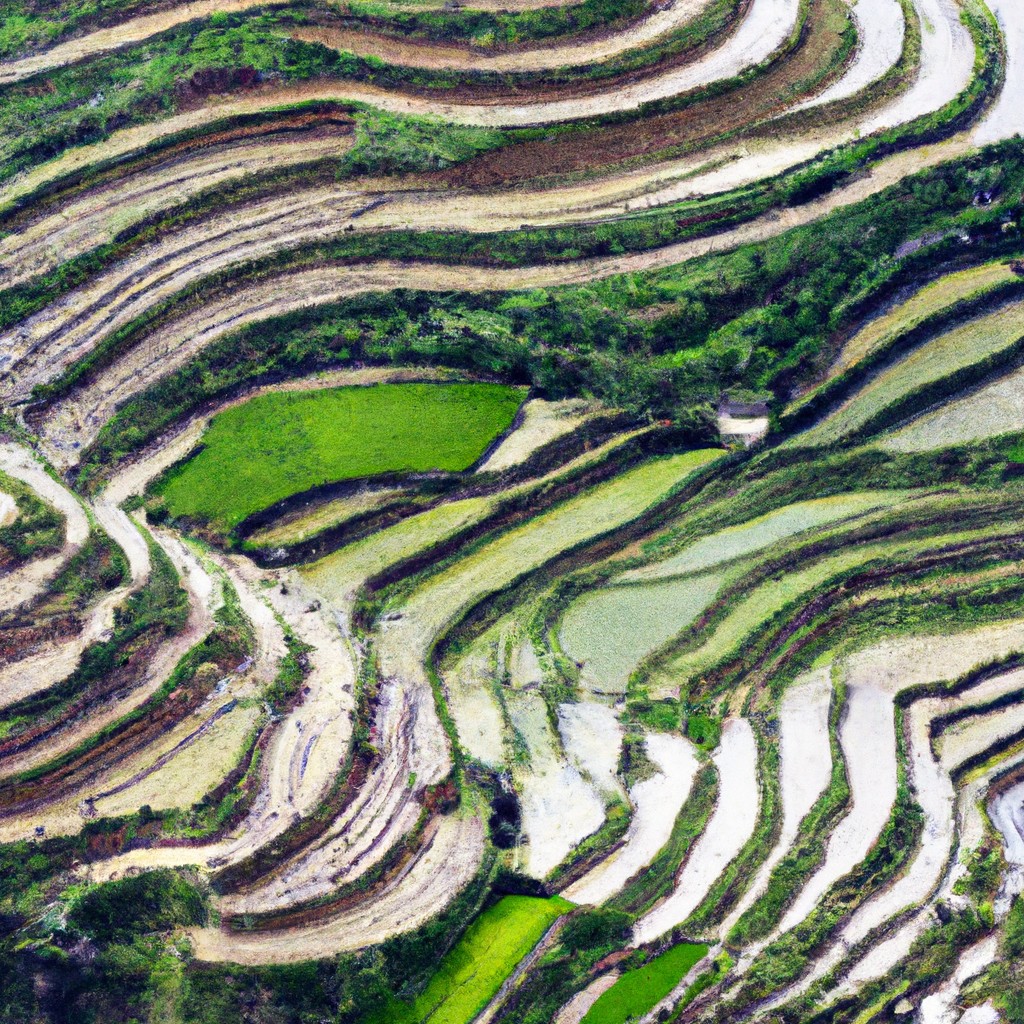Discover how terraces in agriculture help combat soil erosion, improve water usage, and create productive farming spaces on challenging landscapes.
Look Inside:
What Is Terrace Farming?

So picture this: you’re farming on a hill. Not an easy task, unless you’re a mountain goat. That’s where terraces come in. Imagine the steps of a giant staircase cutting across the hillside. Each step, or flat area, is a terrace.
Terrace farming essentially involves carving out flat surfaces into the slopes of hills or mountains. It’s like giving the hill a makeover, one step at a time.
What’s cool about these terraces is how they make hilly land farmable. Flattening slopes helps prevent water from just running off and taking topsoil with it. This type of farming uses gravity to its advantage, distributing water more evenly.
Also, it stops rain from playing bowling with your crops. No more soil strikeouts. Crops like rice, barley, and potatoes love hanging out on terraces because they get the water they need without drowning or needing water wings.
In essence, terraces turn hillside farming from a nightmare into something quite achievable and, dare we say, fun!
Most Common Types Of Terraces
Ah, terrace levels! These nifty steps carved into the hillside come in a few flavors:
First up, we have the bench terraces – the classic. Imagine a giant staircase. They help farmers grow rice and other crops in Asia for a reason.
Next, contour terraces. These bad boys follow the natural curves of the land, like a landscape artist went rogue with a plow. Great for water conservation and reducing soil erosion.
Then, there are stone terraces. Got a bunch of rocks lying around? Perfect. Stack ’em up. They’re solid (pun intended) and excellent for controlling water flow.
Lastly, grassed-backslope terraces. These terraces grow wild grass on their slopes to hold the soil together. It’s like nature’s velcro.
And just like that, terraces turn steep, tricky land into productive, soil-saving agricultural plots. Who knew stepping up your farming game was so literal?
Benefits Of Terrace Farming
First up, say goodbye to soil erosion! Those nifty terrace steps slow down water runoff, letting it soak into the soil rather than wash it away, reducing erosion and saving your precious topsoil for growing those prize-winning cabbages.
Next, terracing boosts water conservation. Those steps act like a series of mini reservoirs catching rainfall and ensuring your crops get the hydration they crave. Forget about playing rain dance; terracing’s got your back.
Got a mountain of dreams but not-so-flat land? Terraces are your friends. They transform hilly, uneven terrain into productive farmland, turning your heart-stopping slopes into gentle, crop-friendly steps.
Who loves richer soil? Terraces do! By preventing nutrient runoff, these farming marvels ensure that your soil remains fertile and ready to nurture everything from rice paddies to vineyards.
Finally, let’s talk biodiversity. Terraces create diverse micro-environments. Each level can support different crops, making it easier to practice polyculture and keep your soil and ecosystem happy. Variety is the spice of life, and your crops will thank you!
How Does Terrace Farming Help In Conserving Soil?
Terrace farming tackles soil erosion like a pro wrestler handles a lightweight opponent. By creating flat platforms, it’s like turning a hill into a giant staircase. This slows down water runoff, reducing the chances of soil being washed away faster than you can say “avalanche.”
Water that would typically rush down the slope gets absorbed more effectively. Think of the terraces as giant kitchen sponges, soaking up that precious H2O and letting it gradually seep into the ground. It’s a hydration strategy plants would toast to, if they could.
And those lovely walls that support the terraces? They act like guardians, holding soil in place. They’re the unsung heroes stopping landslides and keeping everything where it should be.
Terrace farming also encourages organic matter to settle rather than scatter. This makes soil rich and fertile, like a gourmet meal for your crops. Less erosion, more nutrients—sound like a win-win, doesn’t it?
With reduced surface runoff, it decreases the risk of pesticides and fertilizers reaching nearby water bodies. Picture fewer chemicals swimming with the fish. Everyone’s happier.
Crops Grown In Terrace Farming
Rice, corn, and wheat are the stars of the terrace show. Think of them as the crop royalty, rocking those steps like they own the place. These staple crops thrive on terraces, enjoying the well-drained soil and reduced erosion, like the VIP guests at an agricultural party.
But it’s not all about the big three. Vegetables like potatoes and beans also join the terrace fiesta. Imagine them dancing along the terraces, happily soaking up nutrients without fear of a surprise mudslide.
Fruit trees, such as apple and peach, add a dash of sweetness to the lineup. They love terraces because the elevation changes help in managing their watering needs, making them juicy and delightful.
Even tea plants get into the groove. Terraces help them handle rainfall efficiently, ensuring that your morning brew tastes just right.
With terraces, farmers can cultivate a diverse set of crops, making the most of their mountainous or hilly terrain. It’s like Mother Nature’s way of saying, “Let’s have a bit of everything, shall we?” Now that’s what we call an inclusive farming party!




